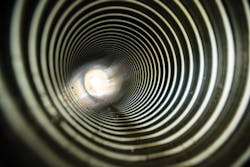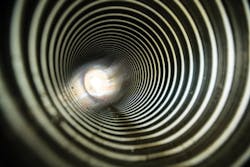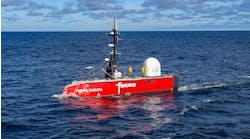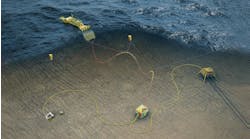Sarah Parker Musarra • Houston
Technip wins Odd Job
Technip picked up a lump-sum contract from Deep Gulf Energy II for the Odd Job development in the ultra-deepwaterGulf of Mexico.
The field is located in Mississippi Canyon blocks 214 and 215 in water depths ranging from 1,330 to 1,823 m (4,364 to 5,981 ft).
Under the contract, Technip will fabricate and install about 23 km (14 mi) of pipe-in-pipe flowline as well as design, fabricate, and install in-line sled, flowline end termination. It will fabricate a jumper. Additionally, will fabricate and install around 2 km (1.2 mi) of steel catenary riser (SCR), as well as perform pre-commissioning services for the flowline and SCR system. The firm will also provide project management and engineering services
Technip’s operating center in Houston will manage the overall project. The SCR and flowline system will be fabricated at its spoolbase in Mobile, Alabama.
The offshore installation is expected to be performed in the summer of 2016 by its ultra-deepwater pipelay and subsea construction vesselDeep Blue.
Odd Job is a single well subsea tieback to the Delta House semisubmersible floating production system. Deep Gulf Energy II says the flowline will be insulated by an outer pipe (pipe-in-pipe) to avoid paraffin and hydrate blockages. The flowline will then be reeled for laying on the seafloor in mid-2016. Startup is planned for 4Q 2016.
DNV GL unveils new RP
DNV GL has launched a recommended practice that allows operators to choose thermoplastic composite pipes instead of steel or traditional flexibles. Thermoplastic composite pipes are a new, robust lightweight pipe alternative that DNV GL says will impact field layout, and installation methods, and ultimately reduce the cost level.
Thermoplastic composite pipes are lightweight yet sufficient for the deepwaters and resilient to fluids and elevated temperatures. They are manufactured in continuous spoolable lengths and are fully bonded, and the same thermoplastic material can be used for the liner, composite layers and
DNVGL-RP-F119 Thermoplastic composite pipes (TCP) was developed through a DNV GL-led joint industry project involving 18 companies covering the whole supply chain- from polymer producers, via TCP manufacturers, to oil companies as the end users.
Espen Cramer, global service director with DNV GL - Oil & Gas, said: “This opens up new, cost-efficient, innovative offshore pipeline solutions, which are of vital importance for reducing overall costs in the industry.”
TCP have a variety of application areas offshore, including: flowlines, risers, jumpers, choke and kill lines, expansion spools, access lines, and chemical injection lines, as well as commissioning and intervention lines.
Statoil issues pipelay/ fabrication contracts
Statoil has awarded three contracts for the linepipe, coating, and installation of the Johan Sverdrup oil and gas export pipelines in the Norwegian North Sea. Total contract value is just under NOK 2.5 billion ($290 million). Mitsui & Co. Norway won the linepipe fabrication contract. The company will supply 220,000 metric tons (242,508 tons) of steel for the oil and gas pipelines.
Linepipe production will start at the Nippon Steel & Sumitomo Metal steelworks in Japan in early 2016.
Wasco Coatings Malaysia will provide external anti-corrosion treatment and concrete weight coating for the oil and gas pipelines, and internal flow coating for the gas line, with all work to be performed at the company’s factory in Malaysia in 2017.
Saipem will perform pipelay from spring 2018 onward, using the lay vesselCastorone.
Stabilized oil will be exported to the Mongstad terminal on Norway’s west coast through a new 274-km (170-mi), 36-in. pipeline connected to existing storage caverns.
Johan Sverdrup’s gas will be exported through a 156-km (97-mi), 18-in. pipeline to the Kårstø gas terminal, with a hot-tap tie-in to the existing Statpipe rich gas pipeline.
This transportation solution is expected to meet the needs for all phases of the Johan Sverdrup development, Statoil added.
Ocean Installer to install Aje subsea spread
Nigeria Folawiyo Aje Services has contracted Ocean Installer to provide offshore construction services for the Aje Phase 1 project offshore Nigeria, operated by Yinka Folawiyo Petroleum. The scope of work includes mooring buoy installation and hook up, and flowline and umbilical installation.
Ocean Installer’s construction support vesselNormand Vision will start offshore operations early next year, with engineering for the project spread among the company’s offices in Stavanger, Aberdeen, and Houston to meet the schedule of this fasttrack project.
The Aje field is in oil mining lease 113 in the Benin basin, 24 km (15 mi) offshore western Nigeria, in a water depth of roughly 900 m (2,953 ft).
First Subsea completes Heidelberg mooring
First Subsea Ltd. has completed the installation of subsea mooring connectors for Anadarko Petroleum Corp.’s Heidelberg truss spar platform, which will be moored in 5,310 ft (1,620 m) of water in field development in the Gulf of Mexico. The 23,000-ton (20,865 metric ton) spar has been moored by nine Series III Ballgrab ball and taper mooring connectors attached to polyester mooring lines.
First Subsea said it is the first manufacturer of offshore mooring connectors to achieve ABS type approval for the design and manufacture of large-scale forgings over 500 mm in diameter.
Saipem, Aker Solutions to cooperate on subsea projects
Saipem and Aker Solutions have agreed to cooperate on targetedsubsea oil and gas development projects worldwide.
The companies will, through a joint work group, identify opportunities where they can create value for customers by combining Saipem’s assets and expertise in engineering, procurement, construction, and installation of subsea infrastructures with Aker Solutions’ capabilities in subsea products and technologies.
The companies will engage with clients from the initial concept and design phase to promote total system engineering, providing the best solutions for construction, operations, and maintenance.




